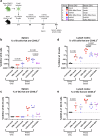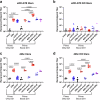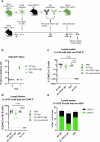Priming VRC01-precursor B cells with non-envelope immunogens disfavors boosting with HIV-1 envelope
- PMID: 40764319
- PMCID: PMC12325944
- DOI: 10.1038/s41541-025-01235-5
Priming VRC01-precursor B cells with non-envelope immunogens disfavors boosting with HIV-1 envelope
Abstract
VRC01-class antibodies are a genetically restricted class of antibodies capable of potently neutralizing diverse strains of HIV-1. Unmutated VRC01 precursors fail to recognize recombinant HIV-1 Envelope (Env) proteins, which necessitated the development of germline targeting vaccine immunogens capable of initiating VRC01-class B cell response. Among these, we developed an anti-idiotypic monoclonal antibody (ai-mAb)-derived VRC01 class targeting immunogen. Because it is distinct from Env, we speculated that the ai-mAb will selectively engage naive VRC01 class B cells while limiting B cell responses directed at off-target epitopes on Env during prime-boost regimens. Here, we evaluated the serum and B cell responses to ai-mAb prime/Env boost, and Env-prime/Env boost regimens in a murine adoptive transfer model where VRC01 precursor B cells are present at physiological levels. We found that the Env-Env regimen led to the greatest expansion of on-target VRC01 B cells, drove larger VRC01-class GC responses, and elicited higher titers of circulating antibodies despite also eliciting substantial off-target Env-specific responses. Single-cell sorting experiments revealed that the ai-mAb was driving off-track somatic mutations. IgG transfer experiments demonstrated that circulating off-target antibodies provide a positive feedback mechanism that potentiates on-target B cell responses. Collectively, the results suggest that non-Env immunogens are not ideal for priming VRC01-class B cells, where sequential boosting with Env will be required to drive maturation of neutralizing breadth.
© 2025. The Author(s).
Conflict of interest statement
Competing interests: L.S. and A.T.M. are inventors on the following patents and applications related to the 426c.Mod.Core protein used herein: US patent #10,342,863—Engineered and multimerized human immunodeficiency virus envelope glycoproteins and uses thereof, US patent #10,987,417—Engineered and multimerized human immunodeficiency virus envelope glycoproteins and uses thereof, US patent #11,883,485—Methods of eliciting antibodies that bind to full-length glycosylated HIV-1 ENV using multimerized ENV cores, and US patent #18/402,480 (pending)—Sequential immunization strategies to guide the maturation of antibodies against human immunodeficiency virus. DJI is named as an inventor on a patent for SMNP: US patent #11,547,672—Nanoparticle vaccine adjuvant and methods of use thereof. All other authors declare no competing interests.
Figures







Similar articles
-
Increased immunogen valency improves the maturation of vaccine-elicited HIV-1 VRC01-like antibodies.PLoS Pathog. 2025 May 29;21(5):e1013039. doi: 10.1371/journal.ppat.1013039. eCollection 2025 May. PLoS Pathog. 2025. PMID: 40440315 Free PMC article.
-
Increased immunogen valency improves the maturation of vaccine-elicited HIV-1 VRC01-class antibodies.bioRxiv [Preprint]. 2025 Mar 14:2025.03.13.642975. doi: 10.1101/2025.03.13.642975. bioRxiv. 2025. Update in: PLoS Pathog. 2025 May 29;21(5):e1013039. doi: 10.1371/journal.ppat.1013039. PMID: 40161829 Free PMC article. Updated. Preprint.
-
Diverse Murine Vaccinations Reveal Distinct Antibody Classes to Target Fusion Peptide and Variation in Peptide Length to Improve HIV Neutralization.J Virol. 2023 May 31;97(5):e0160422. doi: 10.1128/jvi.01604-22. Epub 2023 Apr 26. J Virol. 2023. PMID: 37098956 Free PMC article.
-
The Black Book of Psychotropic Dosing and Monitoring.Psychopharmacol Bull. 2024 Jul 8;54(3):8-59. Psychopharmacol Bull. 2024. PMID: 38993656 Free PMC article. Review.
-
Antiretrovirals for reducing the risk of mother-to-child transmission of HIV infection.Cochrane Database Syst Rev. 2011 Jul 6;(7):CD003510. doi: 10.1002/14651858.CD003510.pub3. Cochrane Database Syst Rev. 2011. PMID: 21735394
References
Grants and funding
LinkOut - more resources
Full Text Sources
Miscellaneous

